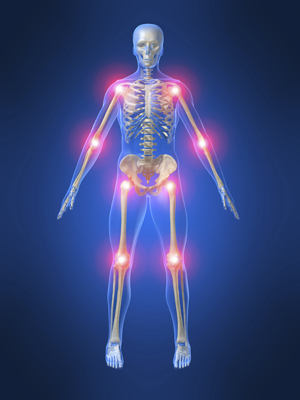
Fascia is a tough, three-dimensional web of connective tissue. Trauma, poor posture, stress, surgical scar tissue and even chemical exposure cause fascia to bind and become “glued.”
by Maria Troia —
Those who are faced with the diagnosis of fibromyalgia often find themselves confused as to what the diagnosis really means and what has caused it. Modern medicine offers little in the way of an explanation beyond a faulty immune system or inflammation. Patients are almost always handed prescriptions, which often cause serious side effects.
Compounding the confusion, unsympathetic people often assert that the pain is all in the fibromyalgia sufferers’ heads and that the diagnosis is a cop-out. But fibromyalgia is real, and the John Barnes Approach to Myofascial Release (MFR) finally offers an explanation of the cause of the condition and a way out of the pain.
What is fascia?
Fascia is a tough, three-dimensional web of connective tissue. Trauma, poor posture, stress, surgical scar tissue and even chemical exposure cause fascia to bind and become “glued.”
It is important to note that while nerves run through fascia, fascia is not innervated by the nervous system. Therefore, unlike muscles, nerves do not tell fascia what to do. On the contrary, fascia actually governs the nervous system.
When damaged, fascia holds up to 2,000 pounds of tensile strength per square inch. Not only do nerves run though it, but so do blood and lymphatic vessels. Additionally, this fascial straightjacket wraps around muscles, organs, bones, joints and even cells, causing pain and dysfunction all the way down to the cellular level. It is also very important to note that fascial restrictions cannot be seen on x-rays or other diagnostic images.
What is MFR?
MFR is an advanced form of bodywork developed by physical therapist John Barnes. It is based on the piezo-electric effect, an engineering term meaning “pressure electric.” Gentle, sustained pressure of at least 90 to 120 seconds turns glued fascia into a soft, fluid state, allowing the system to spontaneously move.
The patient will often come to a significant position in space that can bring up stored tissue memory. This spontaneous movement is specifically known as Myofascial Unwinding and allows the body’s electrical current (also known as qi or vital life force) to course through the area again, eradicating pain. Other forms of bodywork do not wait long enough to engage piezo-electricity and, therefore, cannot get the same level of results.
The role of the emotions and the “thaw-of-the-freeze response”
MFR focuses on the role of the right brain in healing. The right brain is associated with feeling, intuition and inner wisdom. The crux of MFR is that the body and mind cannot be separated or, as Barnes says bluntly in his MFR seminars, “any technique that ignores consciousness is bogus.”
Barnes has based much of his work on the research of Dr. Peter Levine, author of Waking the Tiger, Healing Trauma. Levine suggests a response beyond fight or flight, something he dubbed the freeze response, an autonomic phenomenon that is believed to predate the reptilian brain, and which is unfortunately disregarded in traditional therapy.
The freeze response occurs when an animal is caught by a predator and plays dead, dissociating from his body and physiological function momentarily coming to an actual halt. The trapped animal has two options: (1) if torn to pieces, dissociating will allow him to feel the pain less intensely or (2) if the predator is not terribly hungry, it might look away in distraction, allowing the captured animal an opportunity to jump back into his body and flee to safety.
If the latter happens, we have all seen on the Discovery Channel what follows. Once safe, the animal’s whole body will tremble fiercely. This is an innate response, which Levine terms the “thaw-of-the-freeze response.” It enables the animal to discharge all the trapped energy associated with the fear of imminent death.
Barnes calls this a “profound moment of healing.” Animals do this instinctively. Humans, however, are taught to be tough, shake it off and move on. And in the instance where someone might exhibit the freeze-thaw response (i.e., after surgery or if in shock), modern medicine seeks to stop the thaw with medication or physical restraints.
The body-mind connection is overridden and the trauma simply embeds deeper, waiting for the next layer of stress to create more chaos and pain. This is what is meant by the phrase “the issues are in the tissues.” The body is a fascial hard drive, logging all of it. In the case of fibromyalgia, the hard drive has crashed.
Clinical investigation supporting MFR
An exciting development in this field is the International Fascia Research Congress. The first congress, held three years ago at Harvard Medical School, revealed that cells are “built like tents with an intercellular framework.” The congress presented the “tensegrity” model of the cell, supporting Barnes’s long-held premise that there is a micro-fascial tension system in the cell that creates an opposing and stabilizing force, much like a tent-pole holding up a tent.
Tensegrity is a term coined by Buckminster Fuller, the architect who developed the geodesic dome. If one aspect of the dome is off, even by a fraction, it collapses because tensegrity is lost. And so it is with the tensegrity of our cells.
This is the essence of MFR, all the way to the cellular level, giving fibromyalgia patients an answer that makes sense and offers them a way out of physical and emotional pain.
Maria Troia, MSEd, LMT, NCTMB, CH is trained in the John Barnes Approach to Myofascial Release and AMMA Therapy®. She is a NCBTMB continuing education provider and owner of East-West Holistic Healing Arts in Old Town Scottsdale, Ariz. 480-313-6260 or www.EastWestHolistic.net.
Reprinted from AzNetNews, Volume 29, Number 3, June/July 2010.





February 26, 2012
Bodywork, Fibromyalgia, Inflammation, Myofascial release, Pain